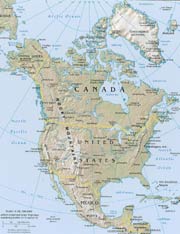Click for labeled map of North America
(Browse all the other World Maps.)
Map of North America links to other maps
- Printable – A map of North America with the countries labeled.
- Outline, Unlabeled
- Political with Shaded Relief – (click on the map to enlarge)
- Political – (black & white)
- Political – (black & white, no labels)
- Landform
- Roads – Go to MapQuest, choose a country and enter a city.
- Weather, Canada
- Weather, Mexico and Central America
- Weather, United States
- Earthquake Activity
- Flags – Clickable map of North America with pop-up flags.
- eBook Maps – Free eBook maps for your eBook device.
- Counties Map – (click on the map to enlarge)
- Physical – (click on the map to enlarge)
- Globe Map – Physical Map on the Globe. (click on the map to enlarge)
North America Of Interest
North America is the world’s third largest continent at 9,365,290 square miles. The continent’s highest point is Mount McKinley in Alaska standing 20,320 feet above sea level and the lowest point is California’s Death Valley, 282 feet below sea level. The world’s third longest river system is the United States’ 3760 mile long Mississippi/Missouri. North America, extending to within 10 degrees of latitude of both the North Pole and the equator, harbors every climatic zone, from tropical rain forest in the lowlands of Central America to areas of permanent ice cap in Greenland.
North America has 7% of world’s population. Most of the people of Canada and the United States are of European descent, but those countries are growing increasingly diverse with substantial immigration from Asia, Latin America, and Africa. People of European descent are a minority in most Central American and Caribbean countries. Christianity is by far the most popular religious practice in North America, followed by Judaism, then Islam. Jamaica has the continent’s highest unemployment rate at over 15% and the lowest unemployment rate is 3% in Mexico.
The first human inhabitants of North America are believed to be of Asian origin. The theory is they crossed over on a land bridge to Alaska from northeast Asia approximately 20,000 years ago then moved southward throughout North America. European discovery and settlement of the continent dates from around 1000 A.D. when Norsemen settled in Greenland. Of even more significance on the subsequent history of the continent was Columbus’s exploration of the Bahamas in 1492 and the West Indies and Central America after that. Cabot’s explorations of Canada in 1497 enabled the English to claim parts of the continent. French and Spanish explorers came soon after and claimed much of North America.
